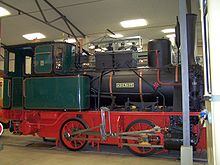Christian Hagans machine factory

The Maschinenfabrik Christian Hagans was a German manufacturer of locomotives .
history
On July 1, 1857, Christian Hagans founded the machine factory on an area on the corner of Kartäuserstraße and Dalbergsweg in Erfurt . In October 1857 the iron foundry was put into operation and in 1858 a mechanical workshop. In the beginning, the production comprised products such as gear wheels , bearing shells and pulleys, from 1870 the manufacture of spare parts for steam locomotives and the construction of locomotive boilers followed . In November 1872, after four months of construction, the first locomotive, a narrow gauge with 785 mm gauge , for the Upper Silesian narrow gauge railways made.
Due to the cramped factory conditions, Hagans often had to limit himself to development. For example, the class T 15 locomotives were built by Henschel under license, as Hagans did not have the necessary capacity and, in particular, no siding . The locomotives with a maximum mass of 35 tons had to be driven with horses as draft animals in multiple horses on transport wagons across the road to the Erfurt freight station. In 1903 a new factory site in Ilversgehofen was acquired. There was a rail connection to the Erfurt Nord train station, which meant that more extensive deliveries were possible without any limitation in weight or dimensions. Production started in Ilversgehofen in 1905 with the Prussian T 9.3 .
By 1913, Hagans had produced 204 T 9s, the largest series of any vehicle built by the company . On June 30, 1915, with effect from April 1, 1916, R. Wolf AG from Magdeburg acquired the locomotive factory from Christian Hagan's sons Otto and Friedrich. In the following years, production in larger numbers consisted exclusively of locomotives for the Prussian state railways .
After production comprised only 25 locomotives from 1924 to 1928, locomotive construction in Erfurt was stopped in August 1928 and the plant closed. Up to then, Hagans had built 1251 locomotives, the serial number 500, a class T 3 locomotive , was delivered on March 29, 1904, the serial number 1000, a class P 8 locomotive , on December 17, 1920. The last Hagans -Lok was a class 64 locomotive . The background to the shutdown was an agreement between R. Wolf AG and Henschel & Sohn . Henschel took over the locomotive quota from Hagans and, in return, stopped building locomotives .
Hagans type
A design for articulated steam locomotives is named after Hagans , in which two coupling wheel groups that can move against one another are connected to one another via a rocker arm system, so that the locomotive manages with a pair of cylinders .
Examples are the Baden VIII d , the Prussian T 13 and the Prussian T 15 .
Preserved locomotives
- U 36.003 (serial number 174, built in 1884), ex Göllnitztalbahn no. 3, at the children's railway in Košice is operational
- HOHEMARK (serial number 438, built in 1900), No. 2 of the FLAG , in the Transport Museum in Frankfurt-Schwanheim
- 89 7462 (serial number 499, built in 1904) is in the DB Museum Koblenz in Koblenz-Lützel , from 1960 to 2000 the playground locomotive in the Cologne Zoo
- 80 013 (factory number 1227, year of construction 1927) is not operational in the German Steam Locomotive Museum in Neuenmarkt - Wirsberg
- 80 014 (serial number 1228, year of construction 1927) is not operational in the South German Railway Museum in Heilbronn
literature
- Friedrich Hagans, Hermann Lohr, Georg Thielmann: Hagans locomotives. Christian Hagans and locomotive construction in Erfurt. Transpress, Berlin 1991, ISBN 3-344-70730-2 .
- Karl-Ernst Maedel : From the steam era. Memories and stories from a past railway era. GeraMond, Munich 1999, ISBN 3-932785-98-3 .
Web links
- http://www.werkbahn.de/eisenbahn/lokbau/hagans.htm
- Company history of the Hagans company ( Memento from June 2, 2008 in the Internet Archive )
Individual evidence
- ^ Detlef Hommel, Georg Thielmann: Erfurt traffic junction. EK-Verlag, Freiburg (Breisgau) 2000, ISBN 3-88255-273-5 , pp. 104-109.
- ^ Karl Ehebrecht: 100 years Buckau-Wolf. The history of our house. From 1838 to 1938. Maschinenfabrik Buckau R. Wolf, Magdeburg 1938, p. 173.
Coordinates: 51 ° 0 ′ 28.8 " N , 11 ° 1 ′ 14.2" E


